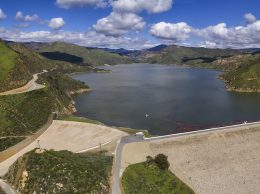Storm water rules go back for revision
IN THIS ARTICLE
- Top Stories Topic
- Stephen Nellis Author
By Stephen Nellis Monday, March 22nd, 2010
Bowing to protests from builders and property owners, state water regulators have reopened the debate on new stormwater rules that could substantially increase the cost of new commercial construction in Ventura County for decades to come.
On March 11, the Los Angeles Water Board agreed to a request from state regulators to hold a new hearing on Ventura County’s Municipal Separate Storm Sewer Systems permit, the so-called MS4 permit approved last May. The remand order, which effectively restarts hearings on the rules, came after protests over the way the rules were written last year.
“It will all be new,” Mary Ann Lutz, chair of the Los Angeles Regional Water Quality Control Board, told the Business Times.
The rules were largely created when officials from Ventura County and several cities met in secret with environmental groups to hammer out an agreement. The agreement was then crammed into the final document at an 11-hour hearing.
“The whole permit is open for review at this time,” said Jeff Pratt, public works director for Ventura County and one of the county officials who met with the environmental groups.
The MS4 regulations affect how new buildings, redevelopments and public works projects address stormwater runoff. At heart, they would require builders to deal with nearly all runoff on-site and bear the costs, which some developers say would make new building more expensive. Public works projects such as road building would have to follow the same rules.
The new hearing, expected in June or July, comes about after the Building Industry Association of Southern California appealed to state water regulators after the MS4 was adopted at the regional level. The group’s petition claimed the Los Angeles Water Board overstepped its authority when it gave the green light to the new rules.
It also alleged that building advocates weren’t given a fair chance to comment on the final document. Large swaths of the permit were negotiated in private talks over several months by Pratt; Rick Cole, Ventura’s city manager; Ed Sotelo, Oxnard’s city manager; Mike Sedell, Simi Valley’s city manager; Dave Beckman, a senior attorney with the Natural Resources Defense Council and representatives from Heal the Bay.
“It was unfortunate that this select group of permittees and a couple of environmental advocacy groups went into a closed room and did not involve all stakeholders,” said Holly Schroeder, executive director of the Building Industry Association for Greater Los Angeles/Ventura. She said that far more practical solutions could have been crafted, “had they had the right set of experts and input in the room.”
The officials who met with environmental groups defended their actions.
“We were faced with an extraordinarily costly permit,” said Cole, Ventura’s city manager. “The cities, to protect the interests of taxpayers and clean water, were willing to sit down with folks who’ve been very influential in the past with the [Los Angeles Water Board]. When you include people, they’re upset when they don’t get their way, and when don’t include people, they sue you. You’re damned if you do and damned if you don’t.”
Cole considers the talks a success. “Even though it’s an expensive permit, the cost to the city and our taxpayers is probably 10 percent of what it was originally going to cost, and we think it delivers 95 percent of the value,” he said.
Pratt, Ventura County’s public works director, said the costs attributable to the MS4 permit looked like they could go from $20 per Ventura County household per year to as high as $80, and even $300 to $400 if certain provisions remained in place.
“It was good we didn’t have anyone else in the room, because we had our own contentions,” Pratt said. “We were all in a room for three or four hours and just beat on each other. By the time we got finished with them and got to something we could all live with, there wasn’t enough time to work with the Building Industry Association or the regional staff.”
Lutz, of the Los Angeles Water Board, said the results of those talks came as news to the board at its meeting in May 2009. “They negotiated a lot of what we saw and put in the permit,” Lutz said. “Our staff wasn’t aware of these negotiations as they were occurring.”
Building advocates say they weren’t aware either, though the environmental groups say they tried to include them.
“We tried to talk through some of the issues,” said Kirsten James, water quality director for Heal the Bay. “We saw early on there wasn’t really a lot of room there to get us to a place that we both could agree upon.”
Citing “apparent irregularities and confusion” about how the permit got approved by the Los Angeles Water Board, state water regulators on March 10 asked the regional board to hold a new hearing on the permit because of “major corrections” that weren’t made public until eight months after the permit was released and “a significant number of documents that may have been omitted from the administrative record transmitted to the State Water Board,” according to a letter from the State Water Board.
Lutz said the new hearing should give all sides a chance to read the full permit and provide input. “That’s the intent here — to give everybody plenty of time to have their points of view made,” she said.
Though the entire permit will be up for review, James of Heal the Bay said her group will push for tidying up procedural loose ends and leaving the rules intact. “We hope they’ll work through those issues and not rehash a permit that’s already fully vetted and decided on,” James said.
Beckman, the Natural Resources Defense Council attorney, said his group made concessions to try to promote infill development in Ventura County. Specifically, the permit sets goals for how much runoff must be dealt with and lays out a range of ways developers can meet them. Projects that can’t do so can pay for similar work off site.
“The idea is that developers can pick the approach that works best for the site and is cost effective and works for their development,” Beckman said. “This permit sets a performance goal and says to the permittee or developer, ‘You meet that goal any way you want.’ ”
The Building Industry Association’s Schroeder remains unconvinced. “We’re looking forward to a hearing where we can present factual evidence that the standard that was instituted in the permit is unworkable and excessive and that this Ventura permit is an outlier,” Schroeder said. “There are better solutions that are more effective for water quality and more practically implemented.”












